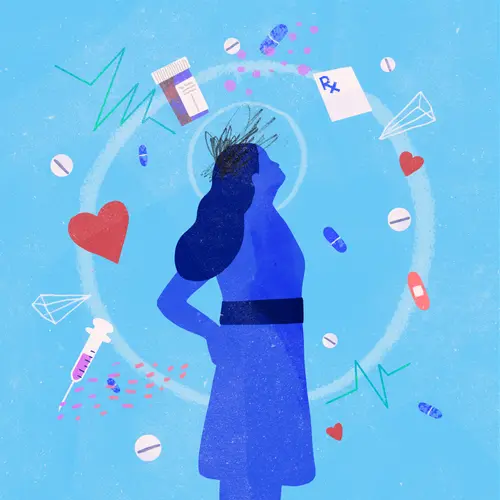Locked-in syndrome is an uncommon neurological condition that usually occurs due to damage to the brain stem. We will look at the causes, symptoms, diagnosis, and treatment options for this rare condition.
What Is Locked-In Syndrome?
Locked-in syndrome is a serious neurological condition that occurs when a section of your brain stem is damaged. This is a rare occurrence that is usually the result of a stroke.
Locked-in syndrome causes paralysis of the voluntary muscles with the exception of the eye muscles. People with locked-in syndrome are aware of their surroundings and retain cognitive abilities like thinking and reasoning but lose control of voluntary muscle movement below their eyes. This makes it difficult for them to move, make facial expressions, or speak.
Locked-in syndrome is classified into three types:
- Classical locked-in syndrome. This condition leads to complete loss of mobility, though people with this form retain their hearing ability.
- Incomplete locked-in syndrome. This is similar to the classical form, but you retain some sensations and the ability to move certain body parts.
- Total immobility locked-in syndrome. People with this condition have complete body paralysis, including eye movements, but retain cognitive abilities. Doctors can determine whether individuals with this condition still have their cognitive skills by identifying cortical functions that indicate regular levels of brain activity.
Those affected retain their sense of hearing and can often communicate using eye movements, blinking, or both. A recent study involving participants with locked-in syndrome found that many of them reported having a happy and meaningful life. Established support systems such as social services can help people with locked-in syndrome live a more normal life at home and in their community.
Locked-In Syndrome Causes
Locked-in syndrome is caused by damage to a specific part of the brain stem known as the pons. The pons is a region in the brain stem containing nerve fibers that connect the medulla oblongata to the cerebellum. In individuals with locked-in syndrome, damage to the pons blocks nerve function and causes paralysis.
The most common cause of damage to the pons is a stroke that affects the brain stem. Other factors that can cause locked-in syndrome include:
- An infection of certain parts of the brain
- Damage to the protective layer of the nerve cells in your brain (called myelin)
- Tumors
- Nerve inflammation
- Other conditions, such as amyotrophic lateral sclerosis (ALS)
Any of these can block the nerve fibers that connect your brain’s gray matter to the spinal cord, which is essential for motor functions. This leads to brain stem damage, especially in those areas critical for actions like facial muscle control, breathing, swallowing, and speaking.
Locked-In Syndrome Symptoms
Symptoms of locked-in syndrome vary depending on the type of condition you have. People with locked-in syndrome are commonly thought to be in a coma in the initial stages and cannot make any voluntary movements. Symptoms include:
- Total paralysis of the limbs and torso
- Difficulty with regulating breathing patterns
- Poor muscle control (ataxia)
- Deeper breaths than usual (hyperpnea)
- Dizziness
- Vertigo
People with locked-in syndrome can sometimes move their eyes vertically but cannot move them from left to right.
Locked-In Syndrome Diagnosis
In many cases, people with locked-in syndrome are assumed to be unconscious, which can lead to a delay in their diagnosis. Diagnosis typically involves ruling out other conditions with similar symptoms and understanding what has caused the condition.
For instance, your doctor may test the activity in specific brain parts and measure your reaction to certain stimulations, such as audio and visual inputs. In some cases, they may check your response to pain stimulation.
Your doctor may also ask you to undergo some of the following tests to help with the diagnosis:
- A cerebrospinal fluid examination determines whether an infection or any other autoimmune condition is causing the symptoms.
- An electroencephalogram (EEG) records the brain’s electrical activity. It helps doctors understand if your brain activity and sleep-wake cycle are regular.
- A cerebral angiography can reveal blood clots in the arteries of the brain stem and other parts of the brain.
- Magnetic resonance imaging (MRI) or computed tomography (CT) scans reveal damage to the pons and other parts of the brain.
- Doctors may also use electromyography to check the activity of your muscles and nerves and identify any possible damage to these structures.
Locked-In Syndrome Treatment
There’s no treatment for locked-in syndrome except treating the underlying condition that has led to it and preventing further complications. People with locked-in syndrome usually need therapy and training to communicate with others. Their therapy mainly focuses on improving motor functionality and enhancing physical functions like speech.
Other modes of treatment include chest physiotherapy, breathing exercises, and regularly changing the individual’s position to enable proper cardiovascular and respiratory function. People with this condition will also need constant support to:
- Recover movement, if possible
- Avoid other complications like pneumonia and urinary tract infections that may arise due to a lack of mobility
- Prevent bedsores
Locked-In Syndrome Recovery
Recovery depends on the type of condition and its cause. Many people can breathe by themselves and even utter words after the first year. Research shows that more than 50% of individuals start eating food within the first year.
According to research, if an individual with locked-in syndrome regains horizontal eye movements within the first four weeks, that could be a sign that improvement is more likely. Regaining other functions like speech and limb movement typically takes much longer, though.
Who Gets Affected By Locked-In Syndrome?
Since diagnosing this condition is challenging, it’s difficult to put an exact number on the individuals affected by it, but most research suggests that this condition is rare.
This condition affects males and females of all ages equally. However, it’s more commonly reported in adults who are at risk of brain stroke and bleeding.

